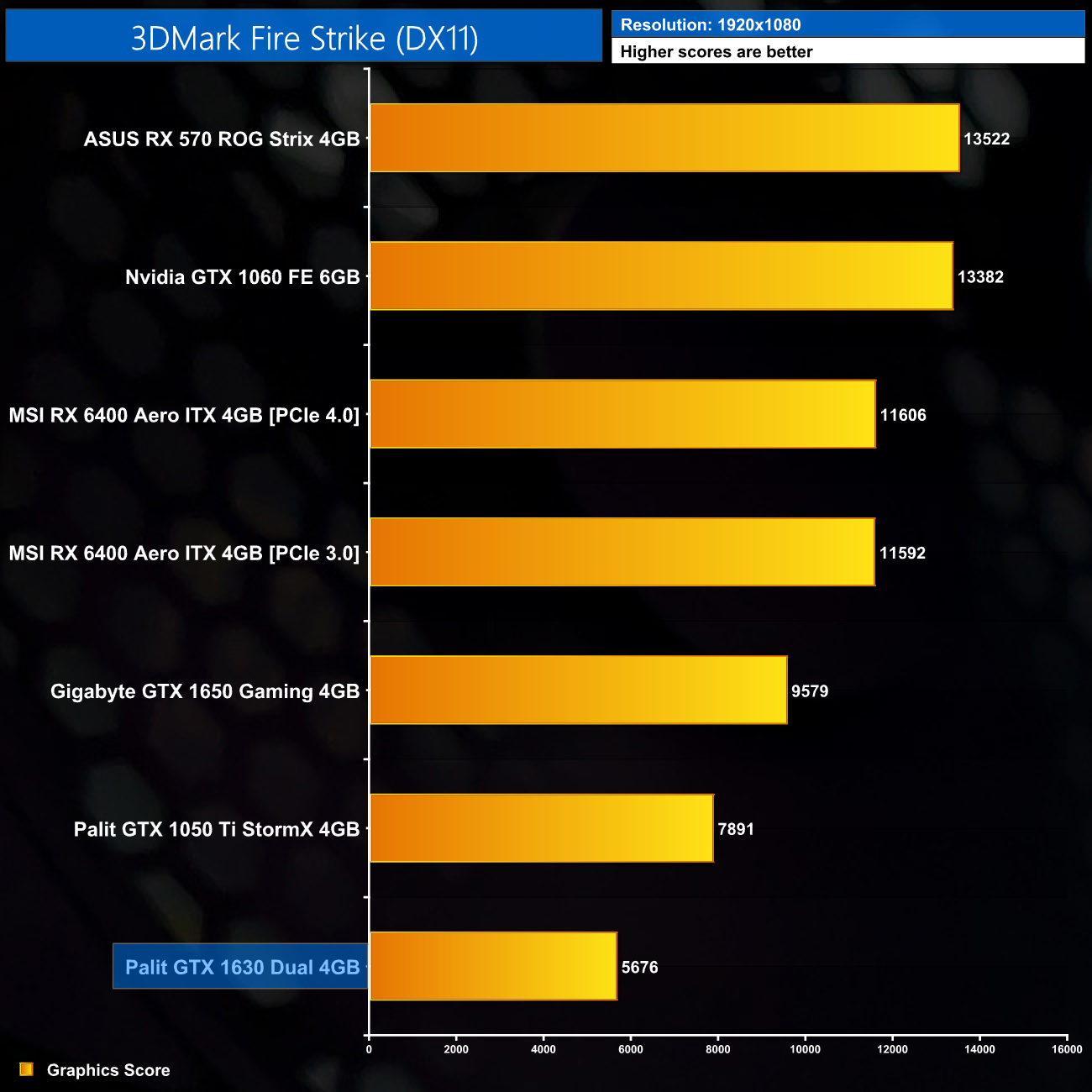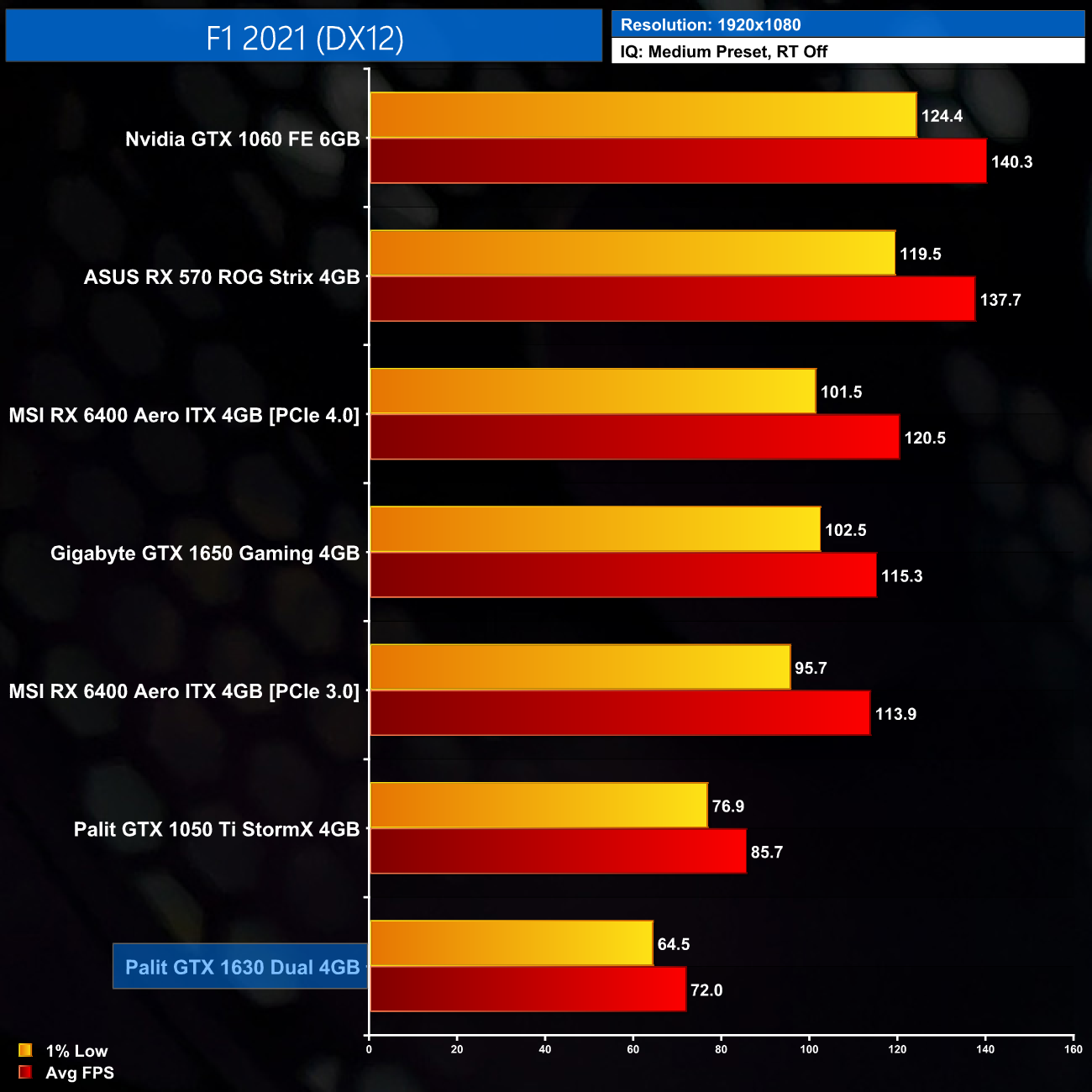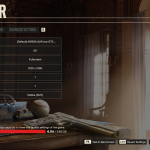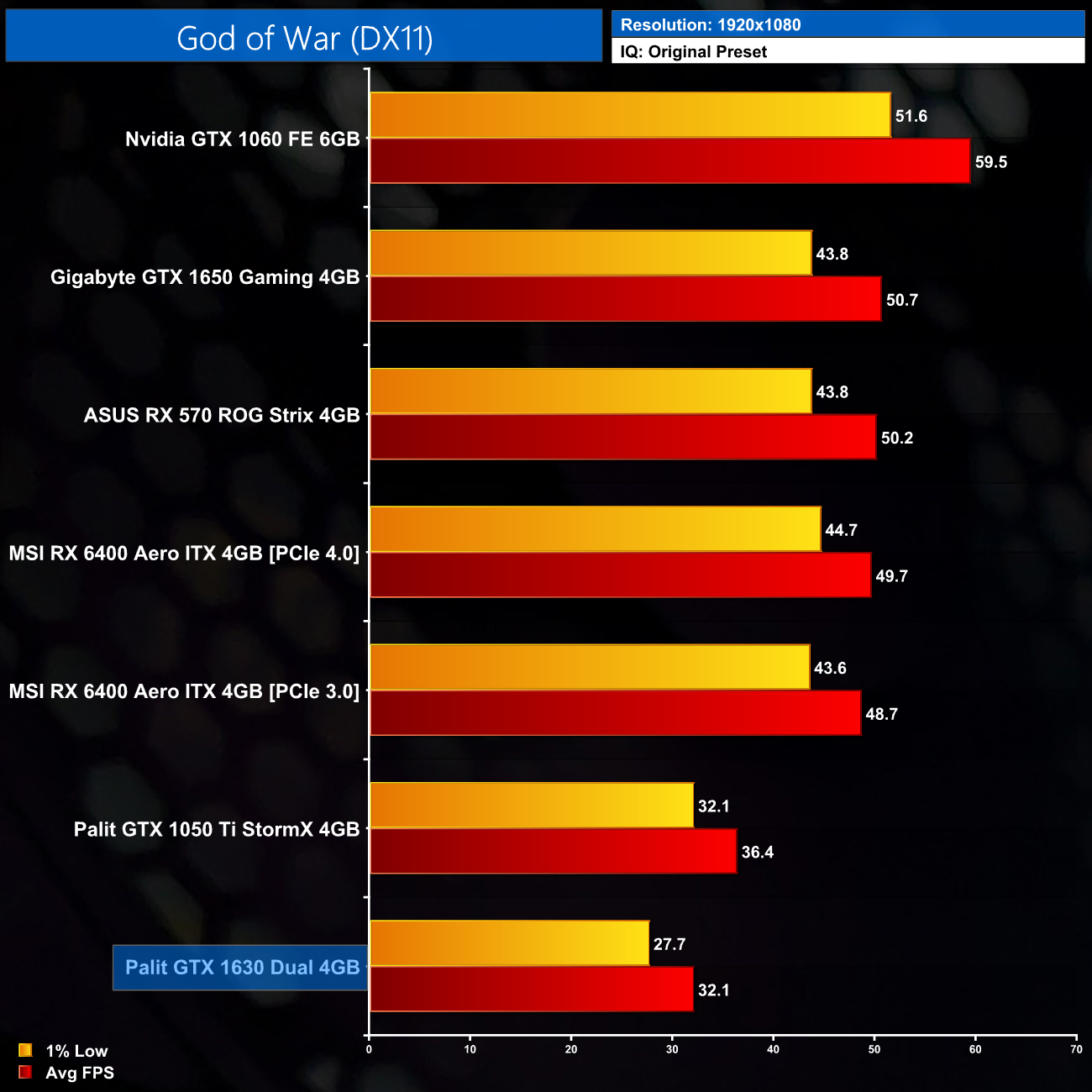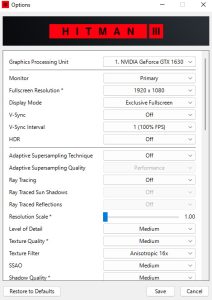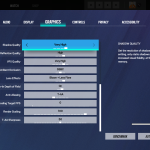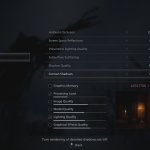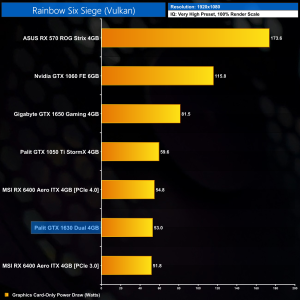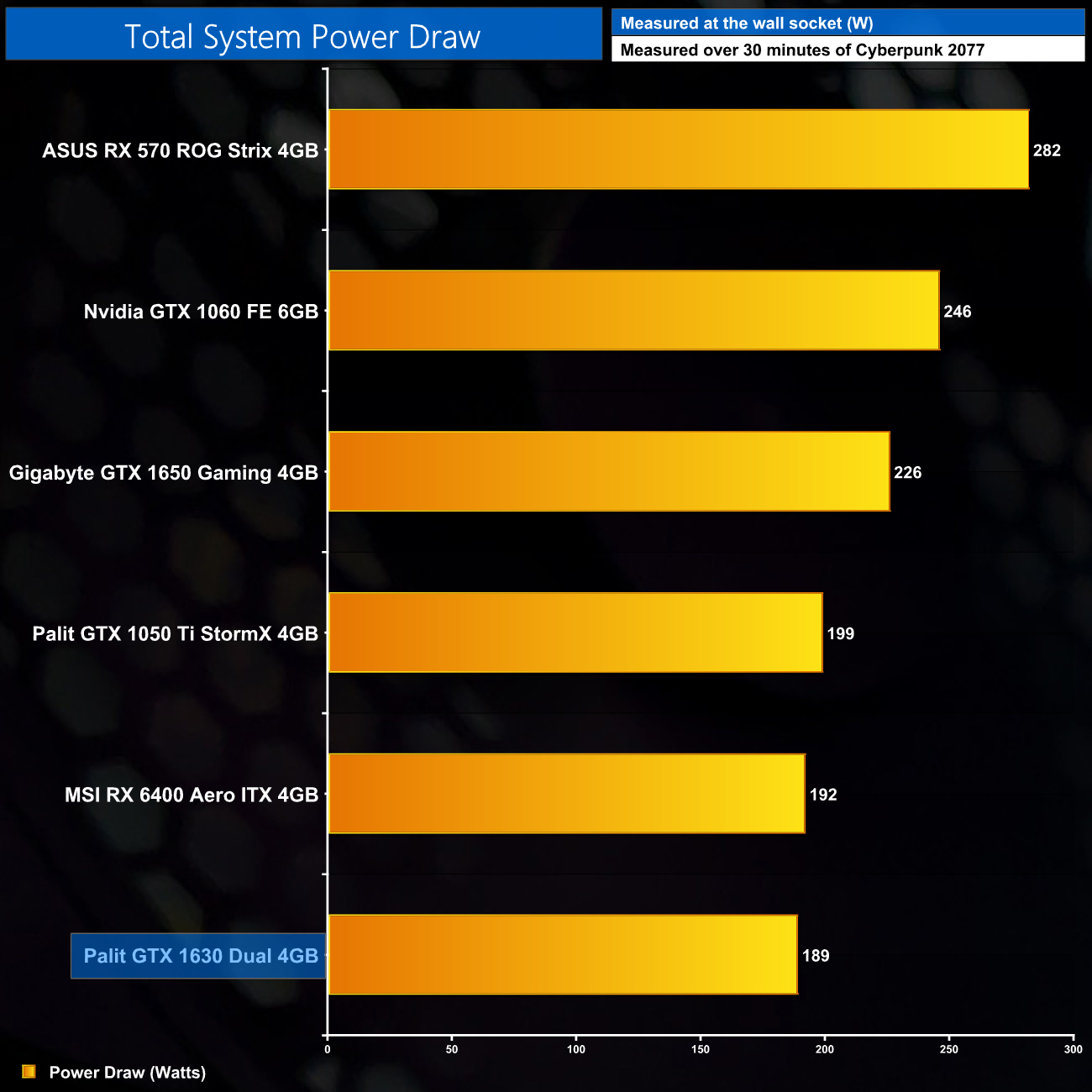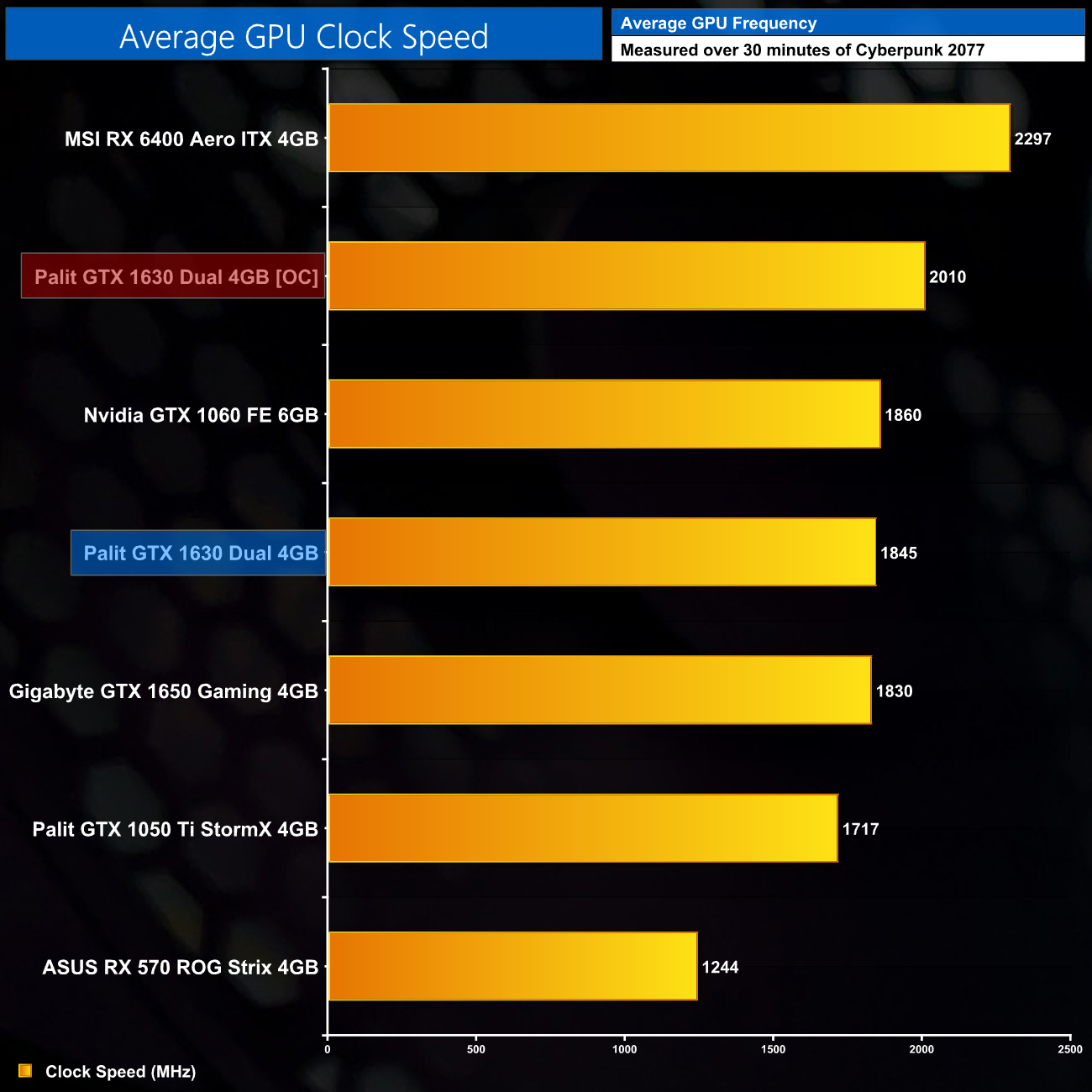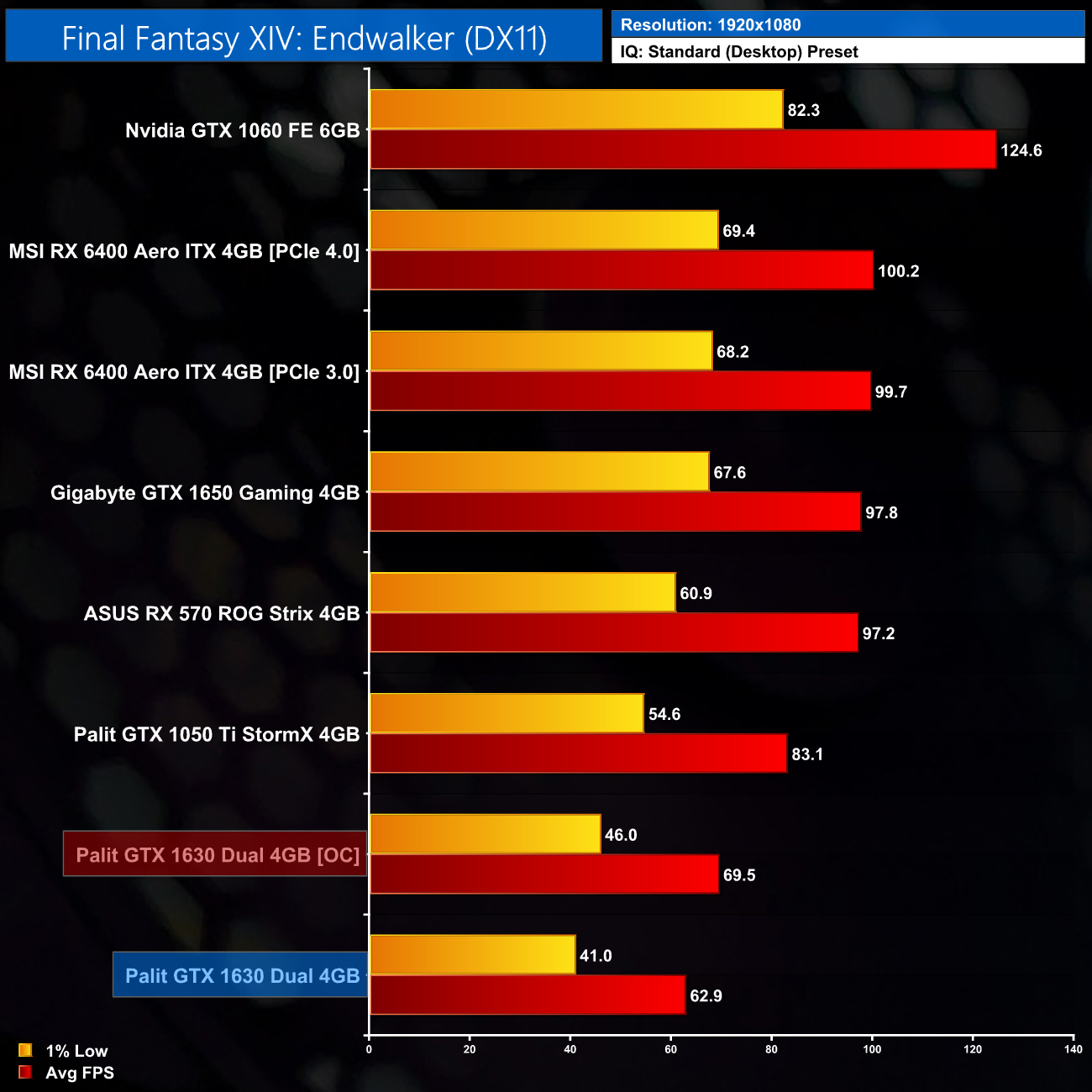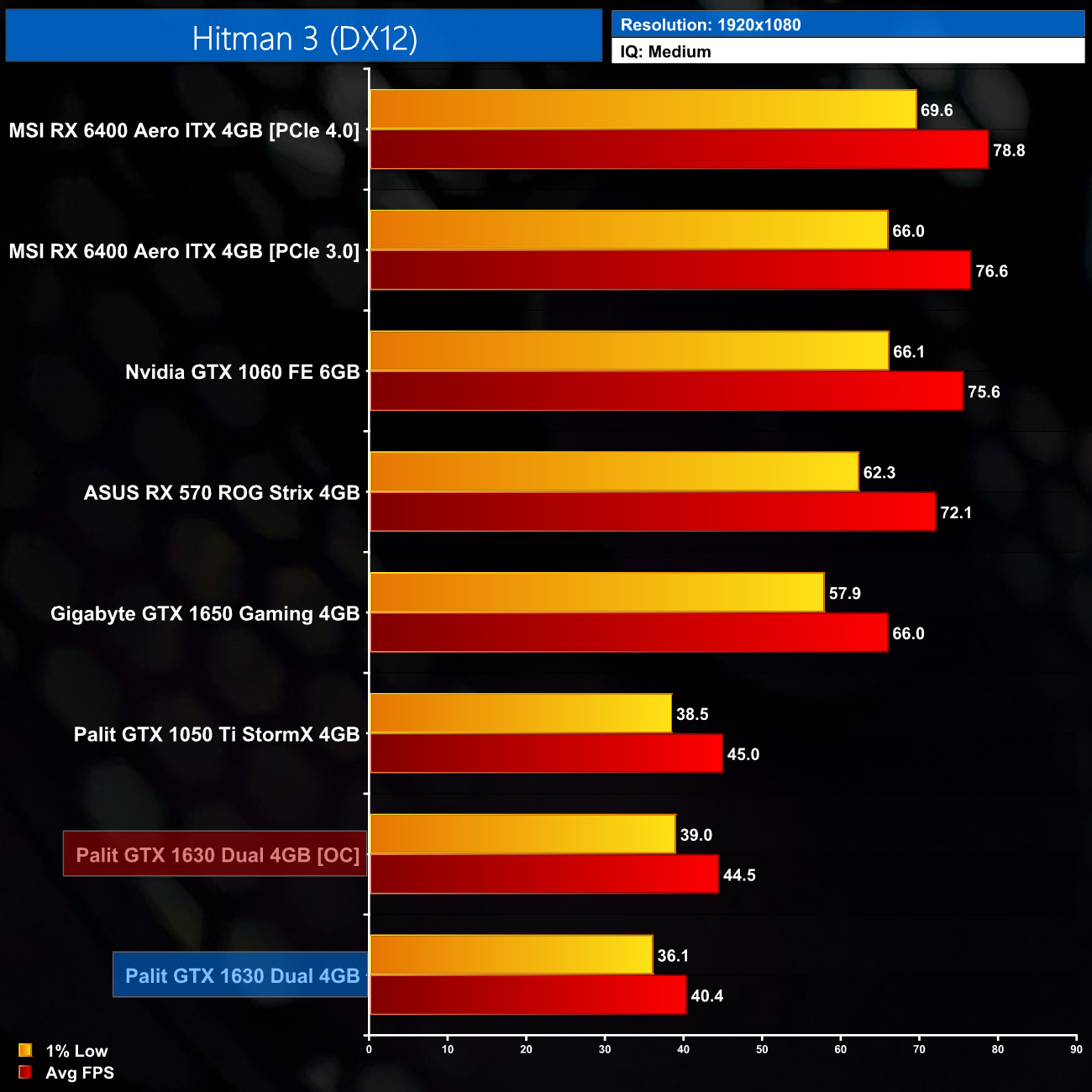
Back from the grave, Nvidia has resurrected the GTX branding for its newest graphics card – the GTX 1630. Calling this ‘new' is somewhat of a stretch however, as GTX 1630 is simply a cut-down version of the GTX 1650 that launched three years ago on the Turing architecture. What sort of performance can we expect from this product? That's what we will find out today…
While the graphics card market had been in turmoil for almost the last two years, things are quickly returning to normal following the crypto crash and a steep drop in demand for GPUs. It is amidst that backdrop that Nvidia has announced the GTX 1630, although this GPU has launched with next to no fanfare and could easily have been missed.
Given the name, it is fair to assume the GTX 1630 is a successor to the GT 1030, and we certainly won't be expecting too much in terms of gaming performance from this card. With UK prices starting at £179.99 however, the GTX 1630 will have to really surprise us to justify that price point…
| GTX 1660 SUPER | GTX 1660 | GTX 1650 SUPER | GTX 1650 | GTX 1630 | |
| GPU | TU116 | TU116 | TU116 | TU117 | TU117 |
| Process | TSMC 12nm | TSMC 12nm | TSMC 12nm | TSMC 12nm | TSMC 12nm |
| SMs | 22 | 22 | 20 | 14 | 8 |
| CUDA Cores | 1408 | 1408 | 1280 | 896 | 512 |
| Texture Units | 88 | 88 | 80 | 56 | 32 |
| ROPs | 48 | 48 | 32 | 32 | 16 |
| GPU Boost Clock | 1785 MHz | 1785 MHz | 1725 MHz | 1665 MHz | 1785 MHz |
| Memory Data Rate | 14 Gbps | 8 Gbps | 12 Gbps | 8 Gbps | 12 Gbps |
| Total Video Memory | 6GB GDDR6 | 6GB GDDR5 | 4GB GDDR6 | 4GB GDDR5 | 4GB GDDR6 |
| Memory Interface | 192-bit | 192-bit | 128-bit | 128-bit | 64-bit |
| Memory Bandwidth | 336 GB/sec | 192.1 GB/sec | 192 GB/sec | 128 GB/sec | 96 GB/sec |
| TGP | 125W | 120W | 100W | 75W | 75W |
First let's take a quick look at the specs. As a cut-down TU117 GPU, the same silicon that was originally used for the GTX 1650, the GTX 1630 sports a total of 8 streaming multiprocessors (SMs). Each SM houses 64 CUDA cores, giving a total of just 512.
We also find 32 texture units and 16 ROPs, while rated boost clock comes in at 1785MHz. Today we are testing the Palit Dual model, which does not ship factory overclocked.
As for the memory configuration, 4GB GDDR6 is standard for the GTX 1630, operating at 12Gbps. Over an extremely narrow 64-bit interface however, that delivers 96GB/s bandwidth, a reduction of 25% compared to the GDDR5 GTX 1650.
Lastly, despite all of its cutbacks, GTX 1630 is still rated at 75W total graphics power, the same as the GTX 1650. This certainly seems odd based on the specs, but we are using our updated GPU power testing methodology in this review, so read on for our most detailed power and efficiency testing yet.
Starting with a look at the Palit GTX 1630 Dual, this ships in a black box, with a large Palit logo written in gold text. On the back, Palit highlights some key features of the GPU in multi-lingual text.
The only included accessory is a small user manual.
As for the card itself, this is an extremely diminutive model that is not much longer than the x16 PCIe connector. It measures 170 x 112 x 40 mm and only weighs 414 grams on my scales.
Despite that, Palit has still managed to squeeze in two fans – hence the name, Dual – and these measure 80mm each. Considering the 75W rated power draw of the GTX 1630, I have no doubt that this will be absolutely fine for cooling purposes.
We can also see Palit using a pretty plain black plastic shroud for the card. It's not especially fancy but doesn't feel overly cheap or flimsy, so I can't complain.
GeForce GTX branding takes pride of place on the front side of the card, while – as expected – there is no backplate used, instead we get a direct view of the back of the PCB.
Somewhat bizarrely, Palit has opted to fit the GTX 1630 Dual with an auxiliary PCIe 6-pin power connector. This is somewhat baffling to me as the 1630 has a TGP of 75W, and you can’t even raise the power limit in something like MSI Afterburner – it’s locked at 75W, so the PCIe slot alone should be able to deliver all the power the card needs.
I asked Palit why they added the 6-pin and they told me, and I quote, that ‘it is more stable to get the power through 6-pin power connector instead of pcie slot.' I don’t quite understand that as Palit themselves also makes a GTX 1650 with no extra power connector – which I know works fine as I reviewed it myself!
Lastly, we can note three display outputs – two DisplayPort 1.4 and one HDMI 2.0.
Driver Notes
- All Nvidia GPUs (except GTX 1630) were benchmarked with the 516.40 driver.
- GTX 1630 was benchmarked with the 516.59 driver.
- All AMD GPUs were benchmarked with the Adrenalin 22.5.2 driver.
Test System:
We test using the a custom built system powered by MSI, based on Intel’s Alder Lake platform. You can read more about this system HERE and check out MSI on the CCL webstore HERE.
| CPU |
Intel Core i9-12900K
|
| Motherboard |
MSI MEG Z690 Unify
|
| Memory |
32GB (2x16GB) ADATA XPG Lancer DDR5 6000MHz
CL 40-40-40
|
| Graphics Card |
Varies
|
| SSD |
2TB MSI Spatium M480
|
| Chassis | MSI MPG Velox 100P Airflow |
| CPU Cooler |
MSI MEG CoreLiquid S360
|
| Power Supply |
Corsair 1200W HX Series Modular 80 Plus Platinum
|
| Operating System |
Windows 11 Pro 21H2
|
| Monitor |
MSI Optix MPG321UR-QD
|
| Resizable BAR |
Enabled for all supported GPUs
|
Comparison Graphics Cards List
- Gigabyte GTX 1650 Gaming OC 4GB
- Nvidia GTX 1060 Founders Edition (FE) 6GB
- Palit GTX 1050 Ti StormX 4GB
- MSI RX 6400 Aero ITX 4GB
- ASUS ROG RX 570 Strix OC 4GB
All cards were tested at reference specifications.
Software and Games List
- 3DMark Fire Strike (DX11 Synthetic)
- 3DMark Time Spy (DX12 Synthetic)
- Cyberpunk 2077 (DX12)
- Dying Light 2 (DX12)
- F1 2021 (DX12)
- Far Cry 6 (DX12)
- Final Fantasy XIV: Endwalker (DX11)
- God of War (DX11)
- Grand Theft Auto V (DX11)
- Hitman 3 (DX12)
- Rainbow Six Siege (Vulkan)
- Resident Evil Village (DX12)
- Total War: Warhammer III (DX11)
- The Witcher 3 (DX11)
We run each benchmark/game three times, and present mean averages in our graphs. We use FrameView to measure average frame rates as well as 1% low values across our three runs.
Fire Strike is a showcase DirectX 11 benchmark for modern gaming PCs. Its ambitious real-time graphics are rendered with detail and complexity far beyond other DirectX 11 benchmarks and games. Fire Strike includes two graphics tests, a physics test and a combined test that stresses the CPU and GPU. (UL).
3DMark Time Spy is a DirectX 12 benchmark test for Windows 10 gaming PCs. Time Spy is one of the first DirectX 12 apps to be built the right way from the ground up to fully realize the performance gains that the new API offers. With its pure DirectX 12 engine, which supports new API features like asynchronous compute, explicit multi-adapter, and multi-threading, Time Spy is the ideal test for benchmarking the latest graphics cards. (UL).
Starting with 3DMark, the GTX 1630 finds itself rooted to the bottom of our charts, in both Fire Strike and Time Spy. In fact, the GTX 1630 is significantly behind the GTX 1050 Ti, which is now almost six years old.
Cyberpunk 2077 is a 2020 action role-playing video game developed and published by CD Projekt. The story takes place in Night City, an open world set in the Cyberpunk universe. Players assume the first-person perspective of a customisable mercenary known as V, who can acquire skills in hacking and machinery with options for melee and ranged combat. Cyberpunk 2077 was released for Microsoft Windows, PlayStation 4, Stadia, and Xbox One on 10 December 2020. (Wikipedia).
Engine: REDengine 4. We test using the Low preset with Medium textures, DX12 API.
As for the game benchmarks, we are starting with Cyberpunk 2077. Even using the Low preset here, but with medium textures, is too much for the 1630 to handle as it averages just 28FPS. That puts it half a frame ahead of the 1050 Ti, which is pretty meaningless, but it is actually the only time we will see the 1630 ahead of the 1050 Ti in our benchmarks today.
Dying Light 2: Stay Human is a 2022 action role-playing game developed and published by Techland. The sequel to Dying Light (2015), the game was released on February 4, 2022 for Microsoft Windows, PlayStation 4, PlayStation 5, Xbox One, and Xbox Series X/S. (Wikipedia).
Engine: C-Engine. We test using the Low preset, with Medium textures, DX12 API.
It’s a similar story in Dying Light 2. Again, using the Low preset but with medium textures is just too heavy for this calibre of GPU, and we see just below 28FPS on average. That puts it 35% behind the GTX 1650, while the RX 6400 actually does even better here, hitting over 50FPS.
F1 2021 is the official video game of the 2021 Formula One and Formula 2 Championships developed by Codemasters and published by EA Sports. The game was released for Microsoft Windows, PlayStation 4, PlayStation 5, Xbox One and Xbox Series X/S on 16 July 2021. The deluxe edition was launched three days earlier on 13 July 2021. (Wikipedia).
Engine: EGO. We test using the Medium preset, ray tracing disabled, DX12 API.
F1 2021 is a less demanding engine and on Medium settings, the GTX 1630 is good for 72FPS on average, which is nice and playable. It’s actually 16% slower than the GTX 1050 Ti however, and about 38% behind the 1650.
Far Cry 6 is a 2021 action-adventure first-person shooter game developed by Ubisoft Toronto and published by Ubisoft. It is the sixth main installment in the Far Cry series and the successor to 2018's Far Cry 5. The game was released on October 7, 2021, for Microsoft Windows, PlayStation 4, PlayStation 5, Xbox One, Xbox Series X/S, Stadia, and Amazon Luna. (Wikipedia).
Engine: Dunia Engine. We test using the Medium preset, HD Textures off, DX12 API.
Far Cry 6 is another heavier title, and using the Medium preset the GTX 1630 averages 40FPS. It’s still a league behind the GTX 1650, which is good for 60FPS in this title, while the 1050 Ti delivers another 5FPS on average too.
Final Fantasy XIV: Endwalker is the fourth expansion pack to Final Fantasy XIV, a massively multiplayer online role-playing game (MMORPG) developed and published by Square Enix for Microsoft Windows, macOS, PlayStation 4, and PlayStation 5. It was released on December 7, 2021, over two years after Shadowbringers, the previous expansion. (Wikipedia).
Engine: Proprietary. We test using the Standard (Desktop) Preset, DX11 API.
A new game for us is Final Fantasy XIV, using the Endwalker benchmark. This is a pretty old but still very popular engine and the 1630 does manage 60FPS on average here, but with choppier 1% lows across the board. The 1630 is still rooted to the bottom of the chart however, and is 24% slower than the 1050 Ti.
God of War is an action-adventure game developed by Santa Monica Studio and published by Sony Interactive Entertainment (SIE). It was released worldwide on April 20, 2018, for the PlayStation 4 with a Microsoft Windows version released on January 14, 2022. (Wikipedia).
Engine: Sony Santa Monica Proprietary. We test using the Original preset, DX11 API.
God of War, using the Original preset, which is the equivalent of medium settings in this game, is another title that’s too demanding for the 1630. We do see 32FPS on average, but with 1% lows below 30FPS, you’d want to use the Low preset here instead. Still, the 1630 remains 12% slower than the 1050 Ti and 37% slower than the 1650.
Grand Theft Auto V is a 2013 action-adventure game developed by Rockstar North and published by Rockstar Games. It is the seventh main entry in the Grand Theft Auto series, following 2008's Grand Theft Auto IV, and the fifteenth instalment overall. It was released in September 2013 for the PlayStation 3 and Xbox 360, in November 2014 for the PlayStation 4 and Xbox One, in April 2015 for Windows, and in March 2022 for the PlayStation 5 and Xbox Series X/S. (Wikipedia).
Engine: Rockstar Advanced Game Engine (RAGE). We test using High settings, with FXAA and 2x MSAA, DX11 API.
Bringing back the ever popular GTA V for this review, the GTX 1630 falls just shy of 60FPS on average when using High settings. It is still considerably slower than the other GPUs we’ve tested, but you can get a playable experience.
Hitman 3 (stylized as HITMAN III) is a stealth game developed and published by IO Interactive for Microsoft Windows, PlayStation 4, PlayStation 5, Xbox One, Xbox Series X/S, Stadia (under the title Hitman: World of Assassination), and Nintendo Switch on 20 January 2021. It is the eighth main installment in the Hitman series and the final entry in the World of Assassination trilogy, following Hitman (2016) and Hitman 2 (2018). (Wikipedia).
Engine: Glacier. We test using Medium settings, VRS off, DX12 API.
As for Hitman 3, using the Medium preset we’re looking at 40FPS on average so you could get away with that sort of performance. The GTX 1050 Ti only managed an extra 5FPS, but then it’s a bit step up to the GTX 1650, which hit 66FPS on average.
Tom Clancy's Rainbow Six Siege is an online tactical shooter video game developed by Ubisoft Montreal and published by Ubisoft. It was released worldwide for Microsoft Windows, PlayStation 4, and Xbox One on December 1, 2015; the game was also released for PlayStation 5 and Xbox Series X and Series S exactly five years later on December 1, 2020.
Engine: AnvilNext 2.0. We test using the Very High preset, with 100% Render Scale, Vulkan API.
Rainbow Six Siege is next, and here we’re using the Very High preset – but do remember this is an old game and the engine is very easy to run, so we still see an average of 84FPS from the GTX 1630. That’s only 7% behind the 1050 Ti, but I’m not sure that’s a good thing for the 1630 all things considered.
Resident Evil Village is a survival horror game developed and published by Capcom. The sequel to Resident Evil 7: Biohazard (2017), players control Ethan Winters, who is searching for his kidnapped daughter; after a fateful encounter with Chris Redfield, he finds himself in a village filled with mutant creatures. The game was announced at the PlayStation 5 reveal event in June 2020 and was released on May 7, 2021, for Windows, PlayStation 4, PlayStation 5, Xbox One, Xbox Series X/S and Stadia. (Wikipedia).
Engine: RE Engine. We test using the Balanced preset, with V-Sync disabled, DX12 API.
Up next we have Resident Evil Village, where the 1630 averaged 41FPS using the Balanced preset. This is dead level with the 1050 Ti, though again it’s still about 38% slower than the 1650, which was able to maintain over 60FPS.
Total War: Warhammer III is a turn-based strategy and real-time tactics video game developed by Creative Assembly and published by Sega. It is part of the Total War series, and the third to be set in Games Workshop's Warhammer Fantasy fictional universe (following 2016's Total War: Warhammer and 2017's Total War: Warhammer II). The game was announced on February 3, 2021 and was released on February 17, 2022.(Wikipedia).
Engine: TW Engine 3 (Warscape). We test using the Medium preset, with unlimited video memory enabled, DX11 API.
Likewise, Total War: Warhammer III is pretty heavy on the 1630, even when using Medium settings. We see an average of 38FPS here, and that makes the GTX 1630 14% slower than the 1050 Ti, and 35% behind the 1650.
The Witcher 3: Wild Hunt is an action role-playing video game developed by Polish developer CD Projekt Red, and first published in 2015. It was released for Microsoft Windows, PlayStation 4, and Xbox One in May 2015, with a Nintendo Switch version released in October 2019, and PlayStation 5 and Xbox Series X/S versions planned for release in Q4 2022. (Wikipedia).
Engine: REDengine 3. We test using the Medium preset, with HairWorks off, DX11 API.
Lastly, we close out with another classic – The Witcher 3. Unfortunately, the trend is now very clear and the GTX 1630 is right at the bottom of the chart. This time, it’s 18% slower than the 1050 Ti and 37% behind the 1650.
Here we present frame rate figures for each graphics card, averaged across all 12 games on test today. These figures can disguise significant variations in performance from game to game, but provide a useful overview of the sort of performance you can expect at each resolution tested.
Looking now at the average performance from across all 12 games, it’s pretty obvious that the GTX 1630 is a very weak gaming GPU, even at lower image quality settings. Its average of 47FPS is 14% behind the 1050 Ti – and remember, that GPU came out in 2016 for about £140. The 1630 is also 36% slower than the 1650, and we won’t even mention the other cards we have tested, like the 570 or GTX 1060, which are all miles faster.
Here we present the average clock speed for each graphics card while running Cyberpunk 2077 for 30 minutes. We use GPU-Z to record the GPU core frequency during gameplay. We calculate the average core frequency during the 30 minute run to present here.
The GTX 1630 ran at a locked 1845MHz over our testing – as you can see from the flat blue line above, it did not budge from this figure at all.
For our temperature testing, we measure the peak GPU core temperature under load. A reading under load comes from running Cyberpunk 2077 for 30 minutes.
In terms of the thermals, the Palit Dual model is absolutely fine. The only comparison I have here is the Gigabyte 1650 Gaming OC, which is a much bigger card, but I’ve not been able to test any other 1630s. Still, the Dual hit 64c on the GPU and then 73c on the hotspot, so absolutely no complains from me.
We take our noise measurements with the sound meter positioned 1 foot from the graphics card. I measured the noise floor to be 32 dBA, thus anything above this level can be attributed to the graphics cards. The power supply is passive for the entire power output range we tested all graphics cards in, while all CPU and system fans were disabled. A reading under load comes from running Cyberpunk 2077 for 30 minutes.
Those thermal results look even better too when we consider noise levels. The two fans only spun up to 32%, or 1100rpm during our testing, resulting in absolutely whisper quiet noise levels. The card is so quiet my sound meter couldn’t actually detect a difference in the environment with the fans on or off, as 32dBa is about the sound floor in my office, so that’s again a huge positive for the Dual.
Here we present power draw figures for the graphics card-only, on a per-game basis for all twelve games we tested at 1080p. This is measured using Nvidia's Power Capture Analysis Tool, also known as PCAT. You can read more about our updated power draw testing methodology HERE.
Per-Game Results at 1080p:
Click to enlarge.
12-Game Average at 1080p:
As for power draw of the graphics card only, despite being rated at 75W, we can actually see the average power draw from over 12 games we tested, comes in at below 50W. GTX 1630 is very light on the juice and brings me back to my point about the 6-pin power connector on the Palit Dual, which just looks completely unnecessary.
Using the graphics card-only power draw figures presented on the previous page, here we present performance per Watt on a per-game basis for all twelve games we tested at 1080p.
Per-Game Results at 1080p:
Click to enlarge.
12-Game Average at 1080p:
Overall efficiency is on-par with the GTX 1630, which is to be expected. Turing is clearly not as efficient as a more modern architecture like RDNA 2, but with such low power draw it was never going to look overly inefficient.
We measure system-wide power draw from the wall while running Cyberpunk 2077 for 30 minutes.
Total system power draw is very low, at around 190W, putting the 1630 roughly level with the RX 6400. Bear in mind we’re using an i9-12900K locked at 4.9GHz, so you can expect to see even lower power figures when pairing this GPU with an i3, for instance.
For our manual overclocking tests, we used MSI Afterburner. Our best results are as below.
As mentioned, the power limit is locked for the GTX 1630 and can’t be increased, but we still managed an extra 160MHz on the GPU. For the memory, we added an extra 690MHz, bringing speeds to 13.3GBps, but trying to push beyond that figure would result in the screen flickering and the graphics driver would reset.
That overclock saw the card’s average operating clock increase from 1845MHz stock, up to 2010MHz, resulting performance increases of 10-11% in the titles we retested, which isn’t bad at all. It’s hardly going to make the card suddenly hit 60FPS in every game, but there is definitely some extra headroom left untapped.
Almost three years on since its last release, Nvidia has brought back the GTX family for what is, perhaps, its final hurrah in the form of the GTX 1630. Being completely honest, if this is the last GTX-branded GPU we see from Nvidia, it is a very limp way for the series to go out after all these years.
Despite that, I don't actually think the GTX 1630 is a bad product. I say that as I am very much looking at this as a GT 1030 replacement – which is likely why it’s been named as the GTX 1630 in the first place. In that sense, I don't think it's terrible. It’s got enough gaming performance to play older or esports titles at low or medium settings, the three display outputs are OK (and a step up from the GT 1030) while we still get H.264 and H.265 encoding, even if the 1630 isn't using the 7th Gen NVENC encoder.
Of course, it is clearly not a gaming powerhouse, coming in on average 14% slower than the GTX 1050 Ti and 36% slower than the GTX 1650. But for a small media PC or as an upgrade for a kid, it will get the job done.
That is, however, before we take pricing into account. Retail listings for the GTX 1630 are few and far between, but I did spot one Zotac model up for pre-order at £179.99. £180 for the GTX 1630.
Even by modern standards, that is absolutely ludicrous. This is more money than what the 1050 Ti launched for, almost 6 years ago, but the 1630 is the slower product. It just makes no sense to me – on what planet is Nvidia living on that this can hit the market at £180? In fact, to make matters worse, actual GTX 1650 models are in stock at the same price, and that is almost 60% faster on average for 1080p gaming.
After the other launches we have seen this year, specifically with the RX 6500 XT, it is hard for me to come to any other conclusion than that the low-end GPU market is just completely broken. The GTX 1630 is just another launch with just outrageous pricing that makes no sense to anyone.
I mean, I can understand why this product exists – Nvidia is likely sitting on a ton of TU117 GPUs, so they decided to make a cut-down model for the budget market. But this should be a £75 graphics card at most, not one costing £100 more than that.
In fairness to Palit, the Dual model we have reviewed today proved an impressive little card, with good temperatures and very low noise levels – it's just that the pricing strategy for the GTX 1630 which is outrageous to me. In 2022 it still makes more sense to buy a second-hand GTX 1060 for around £130 or less, or an RX 570 for around £110, than to get either of Nvidia or AMD's latest products in the sub-£200 market. For gamers, that is depressing and frankly unacceptable.
Discuss on our Facebook page HERE.
Pros
- Very low power draw (but still required 6-pin).
- Updated video outputs compared to GT 1030.
- Palit Dual is highly compact but runs cool and quiet.
Cons
- Outrageous pricing for this level of performance.
- Slower than the GTX 1050 Ti from 2016 (while costing more).
- 6-pin power connector is unnecessary.
- 6th Gen NVENC, rather than 7th Gen.
KitGuru says: GTX 1630 priced at £180 is a kick in the teeth for budget gamers. And that's putting it politely.
 KitGuru KitGuru.net – Tech News | Hardware News | Hardware Reviews | IOS | Mobile | Gaming | Graphics Cards
KitGuru KitGuru.net – Tech News | Hardware News | Hardware Reviews | IOS | Mobile | Gaming | Graphics Cards














